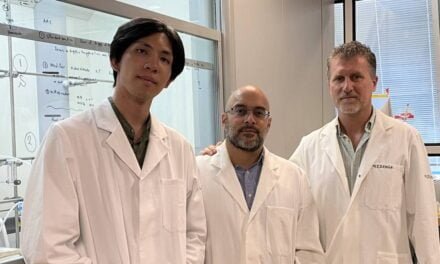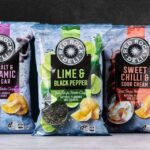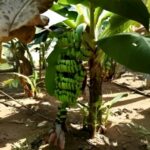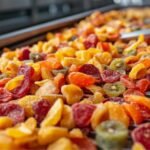Water chestnut, an aquatic angiosperm is one of the most significant minor fruit crops grown in India with the increase in the rising consumer demand for natural foods having good therapeutic values, water chestnut offers an excellent opportunity, write Neha Singh, Rekha Rani and Pratibha Kumari.
Table of Contents
Water Chestnut (Trapa sp.) or Singhada, belonging to the monogeneric family Trapaceae, is a free-floating plant and generally grown in ponds, water-filled in shallow areas in both tropical and sub-tropical countries. The plant is a valuable agricultural product, mainly cultivated for its edible fruit in the northern parts of India, Southeast Asia, and China. In India, the most widely cultivated species have been referred to as Trapa bispinosa Roxb. or Trapa natans L. vat. bispinosa (Roxb.) Makino. It is commonly known as Singhara, ‘Shinghoda’ in Gujrati, ‘Paniphal’ in Bengali, ‘Kubyakam’ in Telgu and ‘Pani Singhara’ in Oriya. It is an excellent source of starch and can be used as a substitute for other starches such as potato, corn, and wheat.
History of Water Chestnut (Singhara or Paniphal)
Water chestnut had been introduced as an ornamental plant by Europe. Its dispersal is limited because of the large, sinking nuts, but the fruit has persisted and spread in the Northeastern states. In the Chinese Zhou Dynasty, water caltrop was an important food for worship as prayer offerings. The rites of Zhou (2nd century BC) mentioned that a worshipper should use a bamboo basket containing dried water caltrops.
In India, it is known as singhara or paniphal (eastern India) and is widely cultivated in freshwater lakes. The fruits are eaten raw or boiled. When the fruit has been dried, it is ground to a flour called singhare ka atta which is used in many religious rituals and can be consumed as a Phalahar diet on the Hindu fasting days, in Indian traditional festival “Navratri”. The Trapa bispinosa is native to Eurasia. It was first introduced to North America in the 1870s, where it is known to have been grown in a botanical garden at Harvard University in 1877. The plant had escaped cultivation and was found growing in the Charles River by 1879.
Unique Features of Water Chestnut Fruit
The interesting feature of the water chestnut is the color and shape of its outer cover, in which the kernel is encased. The water chestnut fruit is covered with a thick, jet-black outer pericarp shaped like a horn protruding from the head of a buffalo. The outer cover is hard, which makes it difficult to peel off to obtain the internal white fruit. Its seeds are called recalcitrant which means they lose viability under reduced moisture and low-temperature conditions (King and Roberts, 1980) and cannot be stored in gene banks.
The indigenous methods used for storing the fruits involve immersing the water chestnut fruits in water in earthen pitchers by farmers. Recent techniques involve in vitro conservation of tissues, coupled with cryopreservation have achieved substantial importance in overcoming the difficulty of germplasm storage of recalcitrant seeds (Withers, 1989, 1991; Chin, 1991).
Uses of Water Chestnut in Fasting Food
The fruit is used as a substitute for cereal in the Indian subcontinent during fasting days. In India, for making flour, the drying of whole water chestnuts is generally done by the old traditional method (Sun-drying), followed by roasting in the sand in large iron pans, which accounts for huge losses of time, the product having a low yield, and in addition, produces a product of low quality. The dried flour is very low in fat and easily digestible, and is helpful for dieting. Its flour is consumed in the form of a sweet dish and puri on several religious occasions.
Besides, it has considerable importance in the manufacturing of products like biscuits, infant’s milk formula, starch as well as alcohol. Thus, this flour is ‘gluten-free’ and can be a good replacement for wheat flour due to the celiac disease caused by gluten intolerance.
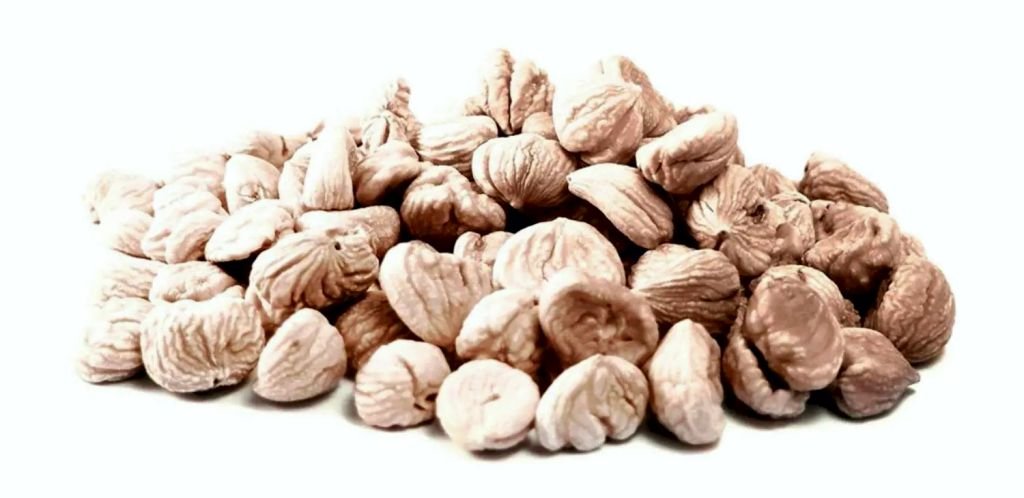
Physico-chemical Properties of Water Chestnut
Table 1 represents the chemical composition of the freshwater chestnut kernel and physical properties of water chestnut flour are given in Table 2.

Nutritional Value of Water Chestnut
Water chestnut fruits are gluten-free, low in fat, cholesterol-free, low in sodium, high in potassium, rich in minerals including calcium, iron, zinc and phosphorous, contains average amounts of fibers as well as are good sources of energy (Adkar et al., 2014).
Water chestnuts contains: moisture content 62.5%, ash 1.04%, crude fiber 2.13%, total soluble sugar 0.92%, reducing sugar 0.33%, non-reducing sugar 0.59%, starch 8.7% and lipid 0.84%. The fresh and green variety of water chestnut (per 100g) contains about 0.275 mg water-soluble protein, 60 µg beta-carotene, 1.1 mg vitamin C and 0.5 mg total phenol.
The minerals composition of green variety comprises of potassium 5.22%, sodium 0.64%, calcium 0.25%, phosphorus 6.77%, sulphur 0.38%, and iron, copper, manganese and zinc 200, 430, 90, and 600 ppm, respectively. The red variety contains about 62.7% moisture, 1.30% ash, 2.27% crude fiber, 0.90% total soluble sugar, 0.30% reducing sugar, 0.60% non-reducing sugar, 8.2% starch, 0.83% lipid, 0.251 mg/100g water-soluble protein, 92 µg/100g beta-carotene, 0.9 mg/100g vitamin C and 0.60 mg/100g total phenol.
Besides, the mineral composition of red variety comprises of phosphorus 6.77%, potassium 5.32%, sodium 0.59%, calcium 0.26%, sulphur 0.32%, copper 450 ppm, iron 200 ppm, manganese 110 ppm, and zinc 650 ppm (Faruk, 2012). The free amino acids, tryptophan, glutamic acid, tyrosine, lysine, alanine, and leucine were commonly found in both varieties. In addition, green and red varieties also contain arginine, proline, cysteine, glutamine, and asparagines, respectively. Biochemical composition of water chestnut is given in Table 3.

Storage and Shelf Life of Water Chestnut
Storage of harvested kernel can be done in the bottom of the fridge in sealed plastic bags or containers to prevent them from drying out. Before storage, the kernels that are damaged during harvesting and later handling are sorted out. Singh et al. (2010) reported that whole water chestnut corms kept at frozen conditions (-18°C) exhibited excellent shelf life in terms of eating as well as visual quality while the corms stored in aqueous conditions at ambient temperature exhibited lowest storage life as 100% of the fruit got spoiled within 40 days.
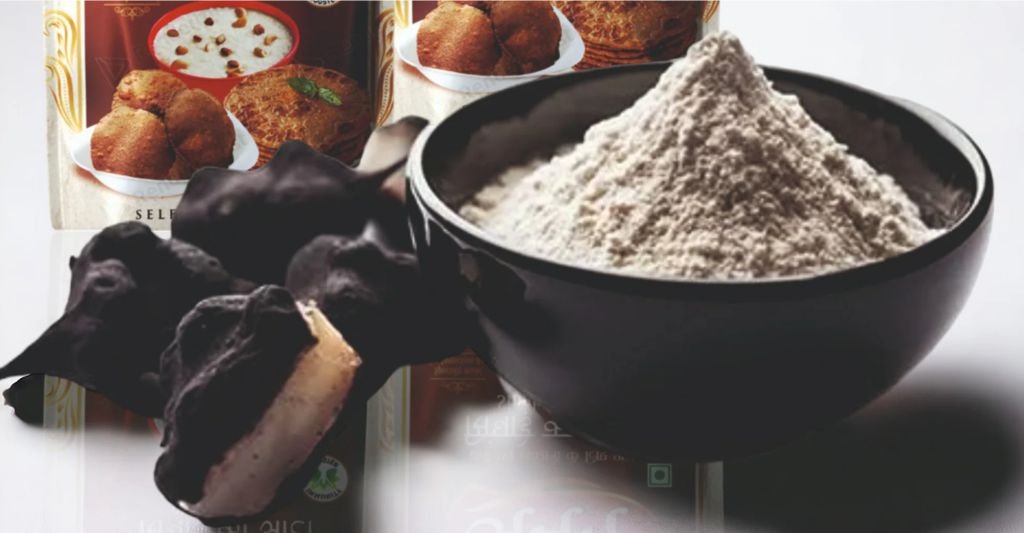
Food Products Prepared by Using Water Chestnut Flour
Water Chestnut Cookies
Cookies were prepared using 90g water chestnut flour, 10g whey protein concentrate (WPC) and 5g potato starch according to AACC micro method (No. 10- 52, 2000). The cookie dough was made by mixing sugar powder (60g), shortenings and essence in Hobart N-50 mixer at 173 rpm for 5 min. After that ammonium bicarbonate (0.7g), sodium-bicarbonate (1.0g), salt (1.0g) and skim milk powder (3.0g), glycerol monosterate (0.5g) were dissolved in water (40 ml) and mixed properly. Finally, flour was added and mixed for 2 min at 58 rpm. The cookie dough was sheeted to 10 mm thickness and cut into a circular shape using 5 cm diameter cutter. The cookies were then baked at 200°C for 10-12 min. The baked cookies were cooled for 20 min and stored in airtight container (Sarabhai and Prabhasankar, 2015).

Singh et al. (2011) prepared the cookie by mixing water chestnut flour and wheat flour in the ratio along with 40 g sugar, 50 g shortening, 1 g NaCl, 0.5 g ammonium bicarbonate and sufficient water was added to make required consistency of cookie dough. The dough was thinly rolled on a sheeting board to a uniform thickness (3.4 mm) and cut using a round cutter to a diameter of 40 mm. The dough pieces were baked in greased pans at 180°C for 15 min. The baked cookies were cooled for 20 min and stored in airtight container.
Water Chestnut Extrudates
The dried blend consisting of water chestnut and potato flour in the ratio 40:60 was moistened by the additional water to make desired moisture content in 14.16%. Then they were kept for 2 h at room temperature to get uniform moisture throughout the blends. The tempered sample then fed to the Brabender single screw extruder under the set operational condition and when these samples came out of the extruder through die expanded due to a sudden release of pressure. After air-drying, they were sprayed with salt and spices and stored in an airtight container (Patel, 2009). Bhatt and Jatav (2017) reported that extruded puff product made from the dough containing 10% water chestnut, 54% corn and 36% rice were mixed with 12.5 gm salt and 15 ml of water resulted in better organoleptic quality and more nutritional elements.

Water Chestnut Pudding
Full cream milk (6% fat and 9% SNF) was taken for preparation of pudding. The milk was then boiled for 5 min and cooled to room temperature. Than water chestnut powder @20%, honey @30%, cocoa powder @2% were added to the milk followed by cooking the mixture for 5-6 min with continuous stirring until the pudding consistency reached. The prepared pudding was cooled to room temperature (25-27°C) before serving (Singh, 2017).
Water Chestnut Cake
At first, the eggs (2 in quantity) were broken in a Hobart mixer and mixed at a very high speed to create a foam-like structure. After that butter (30g) was added and the contents were mixed for 2 min followed by addition of water chestnut flour (50g), baking powder (2g), as well as powdered sugar (54 g) and mixture, was mixed for 2 min. Guar gum @ 0.5g was then added to the mixture and mixed for 5 min. The mold used was coated with butter to avoid sticking of the contents. The batter was then poured into the mold and transferred in a baking oven at a preset temperature of 195+5°C and allowed to bake for 30 min. The prepared cake cooled for 15 min at room temperature. After cooling, the cake was then slowly removed and packed in 100 gauge HDPE airtight packs and stored (Mir et al., 2014).
Water Chestnut Bread
Wheat flour (97g), water chestnut flour (3g) was taken and the yeast was activated in hot water. All the ingredients were mixed and then the prepared dough was kept for incubation at 37°C for fermentation. After 2.5 h the dough was taken out and knocked back to remove the excess gases and was again placed in an incubator for fermentation. The dough was removed after 30 min, knocked back, rolled and moulded into pans and then allowed to ferment for another 35 min. The pan was then placed in a baking oven at 225°C for 30-35 min. The prepared bread was taken out, cooled, sliced and then stored at room temperature (Bhat et al., 2015).
Instant Dry Soup Mix
Peeled and cut water chestnuts pieces (4.0 ± 0.4 mm in size) were dipped in water containing 0.5% potassium metabisulfite and 1.0% citric acid for 30 min. Slices after pre-treatment were dried on a perforated tray drier at 70°C for 24 h. Dried slices were then ground and passed through 177 ìm sieve to obtain fine powder and stored in airtight packs at 4°C till further use (Mir et al. 2014). After that washed bananas were peeled to remove from the flesh and peels were cut into small slices. Peel slices were then dipped in 0.5% (w/v) citric acid solution for 10 min, drained and freeze-dried to reduce enzymatic browning.
The dried peels were grounded into a fine water chestnut powder and stored in airtight packs at 4oC until further use. For product formulation, the ingredients were weighed and mixed in different proportions to form three different formulations. Formulation F1 (water chestnut 45g and banana peel 25g), F2 (water chestnut 55g and banana peel 15g) and F3 (water chestnut 65g and banana peel 5g). Sugar, salt as well as spice mix (onion powder, garlic powder, coriander, pepper) @ 15g, 8g and 7g respectively, were added in the same proportion to all the formulations. The overall acceptability of formula F2 was found to be more acceptable (Rafiq et al., 2018).
Water Chestnut Pasta
Durum semolina and chestnut flour (10% semolina replacement) were used for pasta preparation. Durum semolina and water chestnut flour were mixed in a plastic bowl with a metal stirrer. The water content of the mixture was set to 30% by adding drinking tap water (hardness around 16.5° dH; temperature of water –25°C) and kneaded to form the dough. The mixture was kept for 24 h in a refrigerator at 4°C to equilibrate in a plastic bag. After 24 h, the dough was extruded in the laboratory single screw extruder 19/20 DN extrusion parameters as follows: screw 1:1; flat sheet die head 25×1 mm, temperature profile 80/90/90°C. Extruded pasta having 25% moisture was then air-dried at room temperature for about 24 hours (Kosoviæ et al., 2016).
Conclusion
Water chestnut is considered a good source of nutrition. The crop has tremendous natural attributes viz., storage in the dry condition in the form of nuts and flour. They are the cheap source of food and regarded as a poor man’s food especially in Indian villages where it is the breakfast of the people. Due to its several health benefits, it is good flour for regular consumption, rich in minerals and fibres, alleviates several diseases, if it will be replaced in place of refined wheat flour in foods like a biscuit, pasta, cookies, pizza than these will be considered as healthy food in place of junk food.
Water Chestnut and its Products: FAQs
What is water chestnut and where is it grown?
Is water chestnut flour gluten-free?
What are the nutritional benefits of water chestnut?
How is water chestnut consumed in India?
What food products can be made from water chestnut flour?
How should water chestnuts be stored?
Why is water chestnut considered a healthy alternative to wheat?
References
- Adkar, P., Dongare, A., Ambavade, S. and Bhaskar, V. H. (2014), Trapa bispinosa Roxb.: A Review on Nutritional and Pharmacological Aspects. Advances in Pharmacological Science. 5(8) 37-40
- Alfasane, A., Moniruzzamam, K., Mahbubar Rahman, M. (2011). Biochemical composition of the fruits of water chestnut (Trapa bispinosa Roxb.). Journal of Biological Science. 20(1) 95-98
- Bhat, J., Gull, A., Allaie, F. and Safapuri, T. A. (2015). Physical characteristics and microbial analysis of water chestnut supplemented bread. American Journal of Food Science and Nutrition Research. 2(4) 115-118
- Bhatt, D. K. and Jatav, A. K. (2017). Development and evaluation of ready-to-eat extruded puff product using water chestnut flour. IOSR Journal of Environmental Science, Toxicology and Food Technology. 11(7) 21-26.
- Chin, H. F. (1991). Conservation of recalcitrant seeds. In: Conservation of plant genetic resources through in vitro methods, A. H. Zakri, M.N. Normah, M.T. Senawi and A.G. Abdul Karim (Eds),. Forest Research Institute, Malaysia/Malaysian National Committee on Plant Genetic Resources, Kuala Lumpur, pp. 19-28
- Faruk, M. O., Amin, M. Z., Sana, N. K., Shaha, R. K and Biswas, K. K. (2012). Biochemical analysis of two varieties of water chestnuts (Trapa sp.). Pakistan Journal of Biological Science. 15(21) 1019-1026
- Kosoviæ, I., Jukiæ, M., Jozinoviæ, A., Aèkar, Ð. and Koceva Komleniæ, D. (2016). Influence of chestnut flour addition on quality characteristics of pasta made on extruder and minipress. Czech Journal of Food Science. 34 166-172
- Mann, S., Gupta, D., Gupta, V. and Gupta, R. (2011). Evaluation of nutritional, phytochemical, and antioxidant potential of Trapa Bispinosa Roxb. fruit. International Journal of Pharmaceutical Science. 4(10) 223-228
- Mir, N. A., Gul, K. and Riar, C.S. (2014). Technofunctional and nutritional characterization of gluten-free cakes prepared from water chestnut flours and hydrocolloids. Journal of Food Processing and Preservation. doi:10.1111.jf pp.12311
- Morton, J. F., Sanchez, C. A. and Snyder, G. H. (1988). Indian water chestnuts in Florida: past, present, and future. Florida State Horticultural Society. 16(1) 139-144
- Patel, B. P. S. (2009). Development and evaluation of water chestnut products. M.Sc. Thesis, Jawaharlal Nehru Krishi Vishwa Vidyalaya, Jabalpur, M.P.
- Rafiq, S. M., Vidhu, A. and Rafiq, S. N. (2018). Physico-chemical, sensory and phyto-chemical properties of instant dry soup mix made by using banana peel and water chestnut. European Journal of Biomedical and Pharmaceutical Sciences. 5(5) 795-800
- Sarabhai, S. and Prabhasankar, P. (2015). Influence of whey protein concentrate and potato starch on rheological properties and baking performance of Indian water chestnut flour based gluten free cookie dough. LWT – Food Science and Technology. 63 1301-1308
- Singh, G. D., Riar, C. S., Saini, C., Bawa, A. S., Sogi, D.S. and Saxena, D. C. (2011). Indian water chestnut flour- method optimization for preparation, its physicochemical, morphological, pasting properties and its potential in cookies preparation. LWT – Food Science and Technology. 44 665-672
- Singh, G. D., Singh, S., Jindal, N., Bawa, A. S. and Saxena, D. C. (2010). Physico-chemical characteristics and sensory quality of Singhara (Trapa natans L.): An Indian Water Chestnut under commercial and industrial storage conditions. African Journal of Food Science. 4(11): 693-702
- Singh, S. (2017). Efficacy of water chestnut (Trapa bispinosa) powder for development of functional pudding with honey as sweetening agent. Ph.D. Thesis, Sam Higginbottom University of Agriculture, Technology and Sciences, Allahabad, U.P.
- Withers, L. A. (1989). In vitro conservation and germplasm utilization. In: The Use of Plant Genetic Resources. A.D.H. Brown, D. R. Marshall, D. H. Frankel and J. T. Williams (Eds.), Cambridge University Press, Cambridge, pp. 309-334
- Withers, L. A. (1991). Tissue culture in the conservation of plant genetic resources. In: Conservation of plant genetic resources through in vitro methods. A.H. Zakri, M.N. Normah, A.G. Abdul Karim and M.T. Senawi (Eds.), Forest Research Institute, Malaysia/Malaysian National Committee on Plant Genetic Resources, Kuala Lumpur, pp. 1-18



